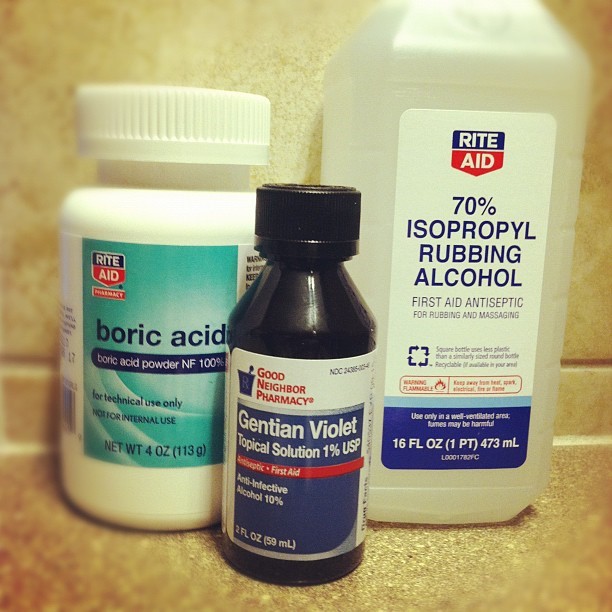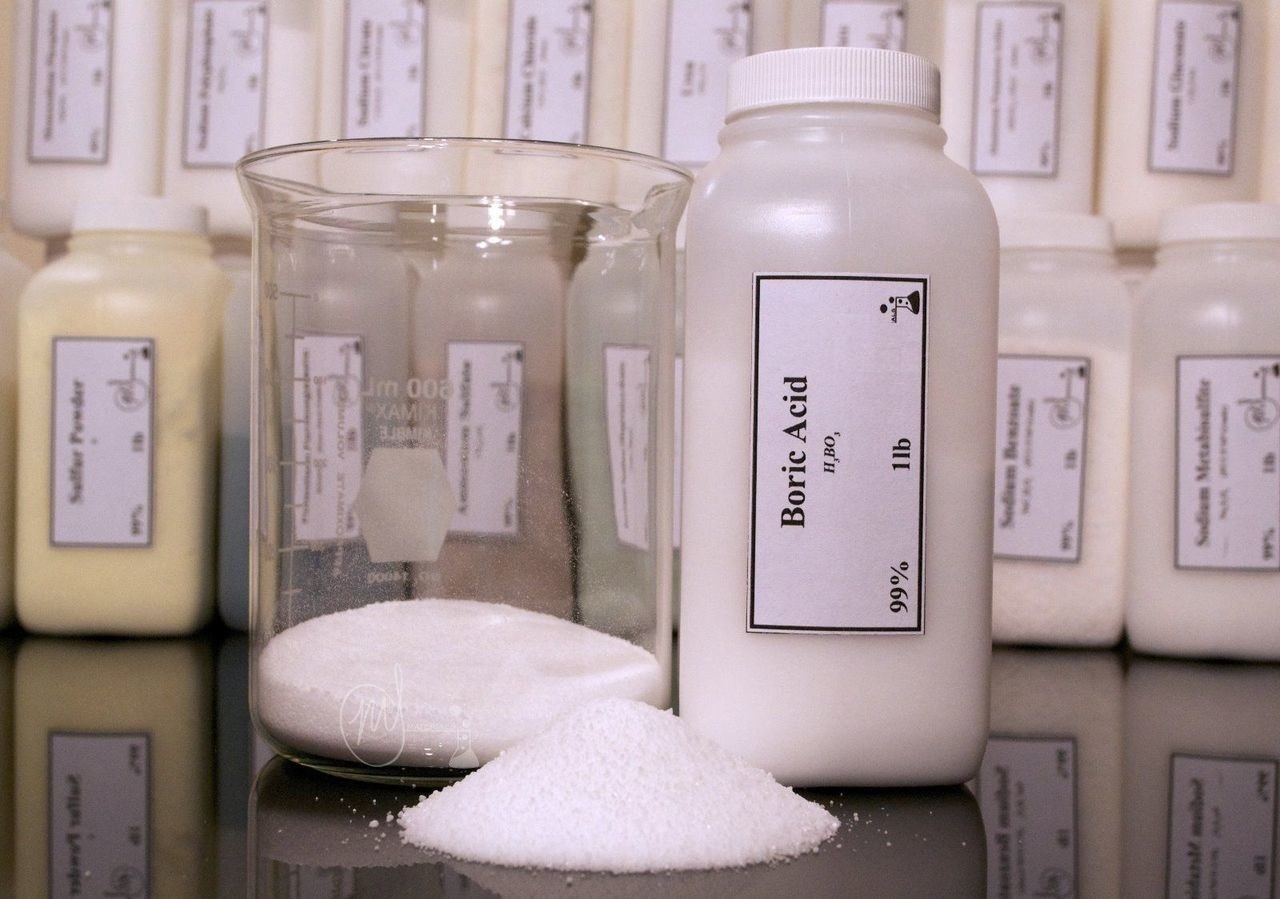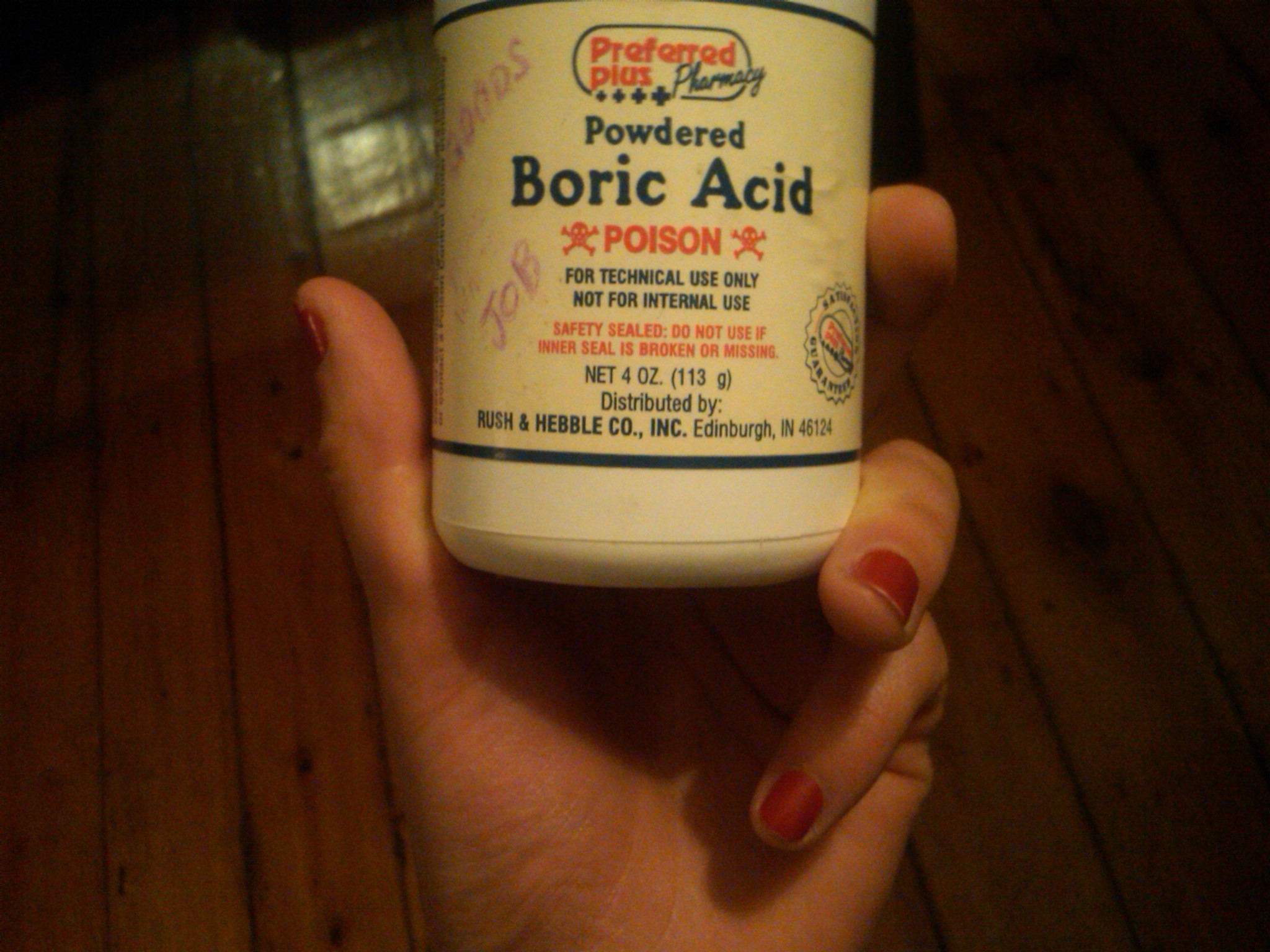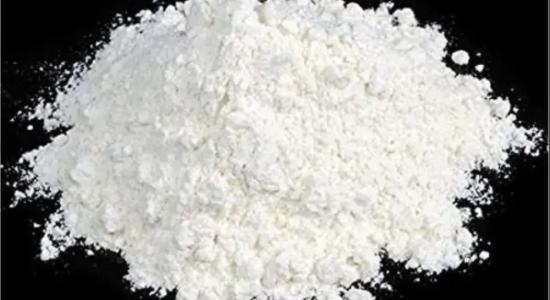See all "Boric Acid" Section Topics

Boric acid for yeast infections is a remedy that will work; however, boric acid is a poison that is used to kill pests, and is used for other industrial processes. For men and non-pregnant woman, it can be a plausible solution. Concerning the women, there has been a lot of research showing boric acid is decently safe to use intravaginally.
You don’t want to use this acid anywhere you have open cuts; as this will cause your body to absorb more boron than may be safe. A study, published in the American Journal of Obstetrics and Gynecology [1981, 141(2):145-148], showed that this treatment was safe for the women in the study to use; and, that little boric acid was absorbed into the blood by vaginal boric acid treatments. The boric acid that did absorb into the blood had a half life of about 12 hours; hence, it did not stay long in the blood even when it did get absorbed.
If you are pregnant, especially if you are in the early stages of pregnancy, boric acid for a yeast infection is a HUGE mistake. According to the U.S. National Library of Medicine’s MedlinePlus article, boric acid use in the early stages of pregnancy is linked to about a 3 fold increase in the chance of your baby having birth defects. This article states: "Intravaginal boric acid has been associated with a 2.7-to 2.8-fold increased risk of birth defects when used during the first 4 months of pregnancy." Thus, it is absolutely not wise to take this alternative remedy if you are pregnant. It just isn’t worth putting your baby (or babies) in danger.
Boric acid may also mimic estrogen in the body, and this can lead to aggravated Candida problems if you take it orally. Candida Hub has an entire article dedicated to the possible negatives of using boric acid for yeast infections. If you have the time, and are interested, check out this article: boric acid vaginal suppository side effects.
A 1/2 Day & Yeast is Gone!
Linda Allen suffered from yeast infections for years. Through researching natural medicine & Candida, she found an efficacious solution!
Linda is one expert you want on your side! Let her show you how to get rid of a superficial yeast infection in just 12 hours; AND, keep it gone!
A 60-day, 100% money back guarantee is provided.
Visit Official Site!How Long Boric Acid Takes to Work

Boric acid really isn’t the fastest, or most reliable, method to control Candida. A significant minority of women, who used boric acid intravagnially in studies, did not get rid of their yeast infections. Although the majority of women using boric acid did get cured, it took 2 to 3 weeks to see results of this treatment. This cure is on the dangerous side; and, it takes a very long time to finally get rid of a yeast infection. Consequently, you would be wise to avoid boric acid and use a faster, safer natural remedy for yeast infections. Let’s talk about some research that provides us with statistics on boric acid vaginal treatments.
One study, published in the American Journal of Obstetrics and Gynecology (Volume 189, Issue 5, November 2003, Pages 1297–1300), looked at 141 women who had tested positive for having Candida glabrata in their vagina. The women all took 600 mg tablets of boric acid intravaginally daily for 2 to 3 weeks. The results found that in one group of women 47 of 73 (64%) were successfully healed; the other group of women in the study had 27 of 38 women (71%) healed. The researchers reported that no advantage was achieved by extending the therapy from two weeks to three weeks. Thus, it is likely that you may be part of the minority of women who do not get healed of your yeast infection by using boric acid. And, if you will be helped, it will take a considerable amount of time to get cured.
Another study, the aforementioned study published in the American Journal of Obstetrics and Gynecology [1981, 141(2):145-148], looked at the efficacy of boric acid for the treatment of Candida albicans induced vaginitis. A double-blind study was conducted. The women in the study took 600 mg intravaginal gelatin capsules on a daily basis for two weeks. Women were examined after treatment for symptoms. Of those studied, 92% of the women using boric acid were cured around 7 to 10 days after terminating treatment. Yet only 72% of the women remained free of symptoms at 30 days after treatment. This suggests that boric acid is not all that effective at stopping yeast infection recurrence; and, that a minimum of a two week therapy regimen is required to achieve a successful cure.
Another study focused on how well boric acid would ameliorate recurrent vaginal yeast infections. The study, was a review of research on this topic, and covered 14 different studies. The study was published in the Journal of Women's Health [20.8 (2011): 1245-1255]. The review found that women who used boric acid had mycological cure (the absence of yeast as determined by laboratory analysis) rates from 40% to 100%. The common regimen, in the various studies analyzed, was 600 mg of boric acid used intravaginally one or two times a day for a duration of 14 days. Concerning the rates of recurrence found by the research, they found no statistically significant difference between studies. Yeast infection recurrence rates for some studies were around 45%. Concerning adverse side effects vaginal reddening, water discharge, and vaginal burning sensations (in less than 10% of cases) were identified in 7 of the studies reviewed. The study concluded with the following statement:
In conclusion, the increase in clinically resistant Candida strains and the more frequent presence of non-albicans Candida in VVC necessitate revaluation of alternative therapeutic treatments. The present clinical evidence suggests that boric acid may be proposed as an effective, safe, and economic treatment of recurrent VVC.
Journal of Women's Health [20.8 (2011): 1245-1255]
Another study looked at how well boric acid would stack up to six other antifungal agents. The study was published in the Journal of Obstetrics and Gynaecology [33.4 (2013): 378-383]. The researchers acquired Candida species from vaginal cultures of 228 non-pregnant, sexually active females. There were 12 different species used; among them being Candida albicans and Candida glabrata. The women either had recurrent vaginal Candidiasis, acute (not recurrent) vaginal Candidiasis, or served as controls. Several micrograms per milliliter concentrations of boric acid were able to inhibit all of the species from all of the groups of women. Boric acid’s minimum inhibitory concentration ranged from 3.28 to 26.24 mcg / mL.
Another study documents the case of a 45 year old woman who had a vaginal infection for an entire year. The study was published in the Journal of Obstetrics and Gynecology [26.6 (2006): 584-584]. The woman stated that she did not have any systemic condition like diabetes mellitus. The treatments she was put on included a variety of antifungal regimens for varying amounts of time. The laboratory findings showed that the woman had a Candida glabrata infection; and, that this strain, was susceptible to fluconazole. Thus, this woman was put on a 200 mg a day regimen of oral fluconazole for 2 weeks. This treatment failed to terminate her symptoms. A combination of antifungal drugs was then tried on the woman for 2 more weeks. Yet, despite this approach, her laboratory findings remained positive for yeast; and, she still had symptoms.
Laboratory tests revealed, that the strain of Candida glabrata infecting the woman, was resistant to multiple drugs. Boric acid was then tried on the woman. She was given 600 mg boric acid suppositories to insert into her vagina once a day for two weeks. The woman did respond well to the boric acid therapy; and, her symptoms greatly improved. A follow up swab obtained at 4 and 8 weeks remained culture negative (they did not grow yeast). The research had the following statement regarding this alternative therapy:
Vaginal insertion of 600 mg gelatin capsules of boric acid for 14 days has been shown to be effective in about 70% of cases. However, 30% of patients in one study, remained culture positive and many patients had a recurrence (Sobel and Chaim 1997). As the long-term effects of boric acid are unknown, a maintenance dose is currently not recommended… Boric acid capsules offer an inexpensive alternative in patients with C. glabrata vaginitis who are resistant to conventional azole group and amphotericin. However, the patient must be made aware of possible recurrences and lack of long-term safety with this drug.
Journal of Obstetrics and Gynecology [26.6 (2006): 584-584]
Eliminate Bacterial Vaginosis & Vaginal Odor
Jennifer O’Brien is one prominent expert on BV that knows how to get rid of vaginal odor. BV is a common infection that you don’t have to put up with.
Jennifer will show you how to naturally eliminate vaginal odor in just 3 days.
A 60-day, 100% money back guarantee is provided.
Visit Official Site!How Much Boric Acid to Use Intravaginally

As both aforementioned studies used, 600 mg of boric acid inserted into the vagina, is what you should also use as well. This dosage level, is the standard treatment course, for intravaginal therapy. Concurrently, MedlinePlus recommends the following dosages intravaginally for the treatment of yeast infections:
- For vaginal yeast infections: 600 mg of boric acid powder one or two times a day.
- For help preventing recurrent Candida (yeast) infections: 600 mg twice weekly.
Clair Goodall: Author & Nature Lover
Clair Goodall is a bee-obsessed natural medicine convert from Minnesota. She is one expert you might want to know more about!
Clair will help you protect you and your family from toxic products and chemicals and help you discover solutions from nature.
Also, Clair’s book is backed by a 60-day, 100% money back guarantee
Visit Official Site!Make Boric Acid Capsules at Home!
If you insist upon using this acid, you can always procure some boric acid powder and put together a few capsules. Try and not go overboard with how much you use. Don’t take more than 600 mg of this powder at a time. This product does have proven antifungal capability. But, you may still not be totally free from recurrent outbreaks of Candida. There is a whole article on Candida Hub giving easy instructions on how to make capsules like this. You may have to wait for the product to ship, but once you have your boric acid powder (and some empty capsules), you can get started! Here is the page on this topic: How to Make Boric Acid Suppositories for Candida Curing.
Potential Side Effects of Boric Acid

If you have a digestive system yeast infection, and are thinking about taking high doses of boric acid to get rid of the Candida in your gut, you are very incorrect in your choice of remedy. Boric acid, when ingested, can cause severe negative physiological effects; and, even prove to be fatal. Make sure you never take boric acid orally in large amounts. And, if you do take small amounts, be sure to talk to a doctor first and follow their instructions.
A Safe, All Natural, 12 Hour Yeast Infection Cure

According to a research paper published in Clinical Microbiology Reviews [12.1 (1999): 80-96], Candida species are quite ubiquitous organisms. Candida are most frequently present in the mouth; and, live in 31% to 55% of healthy people. The species that causes approximately 70% to 80% of all Candida infections is C. albicans.
The Chinese Journal of Obstetrics and Gynecology [2011 Jul;46(7):496] reports there appears to be a correlation between intestinal Candida infections and vaginal yeast infections. And, this provides a clue, as to why yeast infections in general, can reoccur.
This study states, in 148 cases of vaginal candida infections, 33.1% of the women were infected in both the intestines and vaginal area. The recurrence rate of yeast infections, in women with simultaneous intestinal infection, was significantly higher than for women who did not have an intestinal infection. This study concluded that vaginal yeast infections are highly associated with simultaneous intestinal Candida infection.
As research appears to indicate, systemic Candida infections can and do happen. A more systemic Candida infection may primarily get a foothold in the intestines; and cause a wide array of problems. If your yeast infections keep happening, a systemic Candida problem may be why.
One woman who suffered from a systemic Candida infection, for about 12 years, was Linda Allen. The systemic Candida infection that attacked Linda caused a wide range of health problems in addition to yeast infections. Some of these problems, Linda describes in her own words in the following quote:
To be honest, it was hard to pinpoint exactly what was wrong: I wasn’t really sick, but I wasn’t really well either. I had listlessness, fatigue, brain fog, stomach ailments, unexplained rashes, skin infections, and so on. It seemed like every day brought a new challenge.
My energy was sapped and I felt exhausted, which affected my grades and put a big dent in my social life.
Linda Allen’s symptoms included an embarrassing vaginal discharge, severe itching, and burning sensations. Her infections were difficult to deal with, and Linda’s health problems cost her financially as well. Linda states these infections of Candida can become excruciating when they happen as frequently as a menstrual period.
Yet, Linda spent a great deal of time in research; and even questioned health professionals who were kind enough to share some time with her. Linda even tried an array of purported "cures." Although it took a while, eventually, Linda put together a natural treatment plan she hoped would solve her Candida situation.
After spending about a year refining her new approach, Linda tried her system on herself. It worked amazingly well. Linda even returned to a few medical doctors to get tested for the presence of infections. These tests revealed all indicators of infection had vanished! Linda was indeed well again, after such a long, difficult journey.
Linda has since published a book detailing how to copy her success. She also includes a 12 hour yeast infection cure that can get rid of a superficial (such as a genital yeast infection or oral thrush) yeast infection in about 12 hours.
Linda’s publisher protects those who get her book with a 60 day, 100% money back guarantee. Linda’s publisher, a subsidiary of the United States based firm Keynetics Incorporated, is a reputable digital retailer that has been around for a long time. They have great customer service, and make getting a full refund on Linda’s book quick and easy. If you’re not satisfied, you can quickly get all your money back.
If you would like to learn more about Linda’s journey to freedom from Candida, see reviews of others who tried her natural system, or find out more about her efficacious book; you can find more information at Linda Allen’s website.
Author: Mr. Nicholas Gross

Nick Gross is a natural medicine enthusiast who has been researching and writing about natural medicine since 2008. Nick is primarily a web developer but also researches and authors written and video content about natural health. Nick has a bachelor’s degree in Management Information Systems from the University of Northern Iowa.
Disclaimer
The information on this website is not a prescription for anyone. This information is for informational or educational purposes only, and is not a substitute for professional medical advice or consultations with healthcare professionals.
Affiliate Disclosure
Some of the links provided on this website are affiliate links. When a purchase is made through these links, Candida Hub earns money from commission. This helps to keep the website up and helpful to people for free. Thank you for any support!
Stay Up to Date
If you enjoyed this article, consider following / liking our Facebook page. This page is primarily utilized to alert followers of new articles that are put on Candida Hub. Candida related news is also discussed. While you are there, you can see what has been more recently added to Candida Hub.
SOURCES:
- http://www.ncbi.nlm.nih.gov/pubmed/7282789 — Van Slyke, K. Keller, V. Pender Michel, and M. F. Rein. "Treatment of vulvovaginal candidiasis with boric acid powder." American journal of obstetrics and gynecology 141.2 (1981): 145-148.
- https://www.nlm.nih.gov/medlineplus/druginfo/natural/894.html — Medline Plus article on Boron — intravaginal use causes birth defects
- http://www.ncbi.nlm.nih.gov/pubmed/14634557 — Sobel, Jack D., et al. "Treatment of vaginitis caused by Candida glabrata: use of topical boric acid and flucytosine." American journal of obstetrics and gynecology 189.5 (2003): 1297-1300.
- http://dx.doi.org/10.1089/jwh.2010.2708 — Iavazzo, Christos, et al. "Boric acid for recurrent vulvovaginal candidiasis: the clinical evidence." Journal of Women's Health 20.8 (2011): 1245-1255. PubMed
- http://dx.doi.org/10.3109/01443615.2013.767323 — Kalkanci, A., et al. "Candida vaginitis in non-pregnant patients: a study of antifungal susceptibility testing and virulence factors." Journal of Obstetrics and Gynaecology 33.4 (2013): 378-383. PubMed
- http://dx.doi.org/10.1080/01443610600831217 — Dhingra, S., and C. K. Roseblade. "Boric acid for refractory candida glabrata vaginitis." Journal of obstetrics and gynaecology 26.6 (2006): 584-584. PubMed
- https://doi.org/10.1128/CMR.12.1.80 -- Fidel, Paul L., Jose A. Vazquez, and Jack D. Sobel. "Candida glabrata: review of epidemiology, pathogenesis, and clinical disease with comparison to C. albicans." Clinical Microbiology Reviews [12.1 (1999): 80-96].
- https://pubmed.ncbi.nlm.nih.gov/22041440/ -- Lin XL, Li Z, Zuo XL. "Study on the relationship between vaginal and intestinal candida in patients with vulvovaginal candidiasis." Chinese Journal of Obstetrics and Gynecology (Zhonghua fu chan ke za zhi). [2011 Jul;46(7):496].








